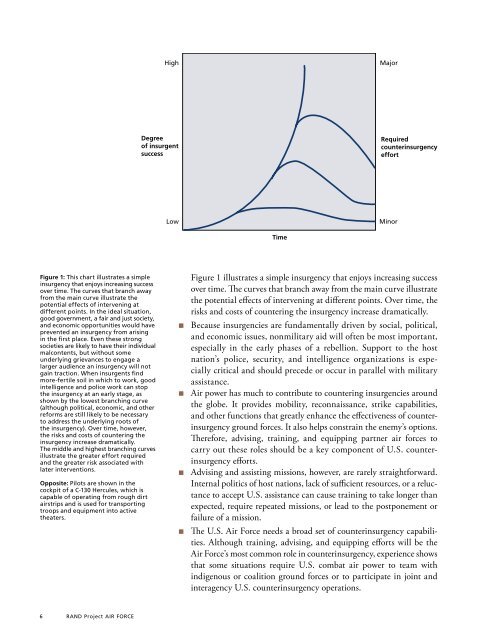RAND Project AIR FORCE Annual Report 2007 - RAND Corporation
RAND Project AIR FORCE Annual Report 2007 - RAND Corporation
RAND Project AIR FORCE Annual Report 2007 - RAND Corporation
You also want an ePaper? Increase the reach of your titles
YUMPU automatically turns print PDFs into web optimized ePapers that Google loves.
HighMajorDegreeof insurgentsuccessRequiredcounterinsurgencyeffortLowMinorTimeFigure 1: This chart illustrates a simpleinsurgency that enjoys increasing successover time. The curves that branch awayfromthemaincurveillustratethepotential effects of intervening atdifferent points. In the ideal situation,good government, a fair and just society,and economic opportunities would haveprevented an insurgency from arisinginthefirstplace.Eventhesestrongsocieties are likely to have their individualmalcontents, but without someunderlyinggrievancestoengagealarger audience an insurgency will notgain traction. When insurgents findmore-fertile soil in which to work, goodintelligence and police work can stoptheinsurgencyatanearlystage,asshownbythelowestbranchingcurve(although political, economic, and otherreforms are still likely to be necessaryto address the underlying roots ofthe insurgency). Over time, however,therisksandcostsofcounteringtheinsurgency increase dramatically.Themiddleandhighestbranchingcurvesillustrate the greater effort requiredandthegreaterriskassociatedwithlater interventions.Opposite: Pilots are shown in thecockpitofaC-130Hercules,whichiscapable of operating from rough dirtairstrips and is used for transportingtroops and equipment into activetheaters.Figure 1 illustrates a simple insurgency that enjoys increasing successover time. The curves that branch away from the main curve illustratethe potential effects of intervening at different points. Over time, therisks and costs of countering the insurgency increase dramatically.Because insurgencies are fundamentally driven by social, political,and economic issues, nonmilitary aid will often be most important,especially in the early phases of a rebellion. Support to the hostnation’s police, security, and intelligence organizations is especiallycritical and should precede or occur in parallel with militaryassistance.Air power has much to contribute to countering insurgencies aroundthe globe. It provides mobility, reconnaissance, strike capabilities,and other functions that greatly enhance the effectiveness of counterinsurgencyground forces. It also helps constrain the enemy’s options.Therefore, advising, training, and equipping partner air forces tocarry out these roles should be a key component of U.S. counterinsurgencyefforts.Advising and assisting missions, however, are rarely straightforward.Internal politics of host nations, lack of sufficient resources, or a reluctanceto accept U.S. assistance can cause training to take longer thanexpected, require repeated missions, or lead to the postponement orfailure of a mission.The U.S. Air Force needs a broad set of counterinsurgency capabilities.Although training, advising, and equipping efforts will be theAir Force’s most common role in counterinsurgency, experience showsthat some situations require U.S. combat air power to team withindigenous or coalition ground forces or to participate in joint andinteragency U.S. counterinsurgency operations.6 <strong>RAND</strong> <strong>Project</strong> <strong>AIR</strong> <strong>FORCE</strong>
















